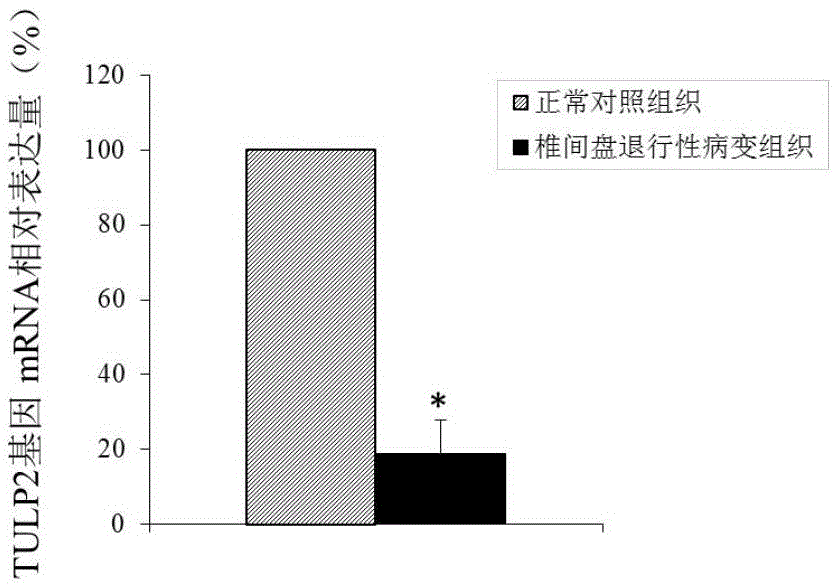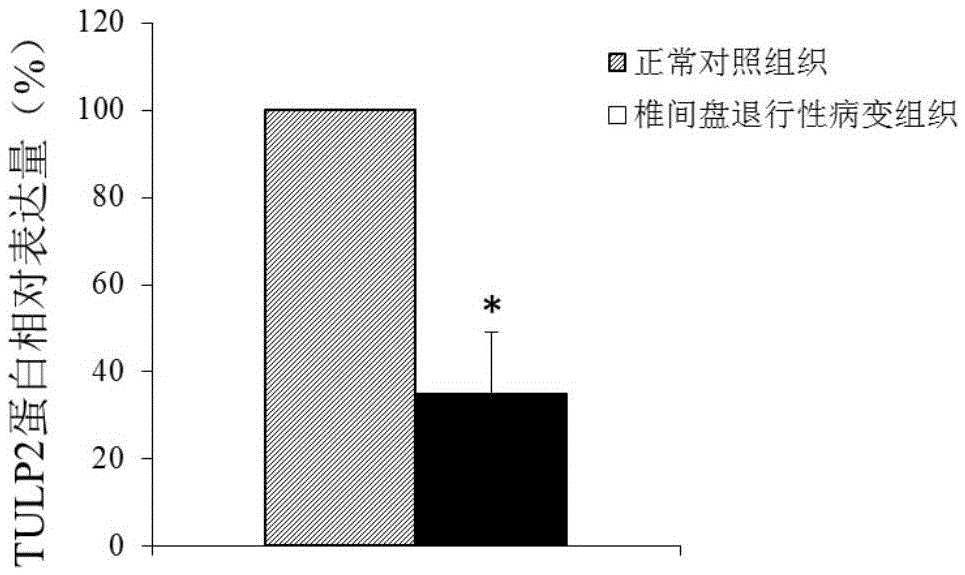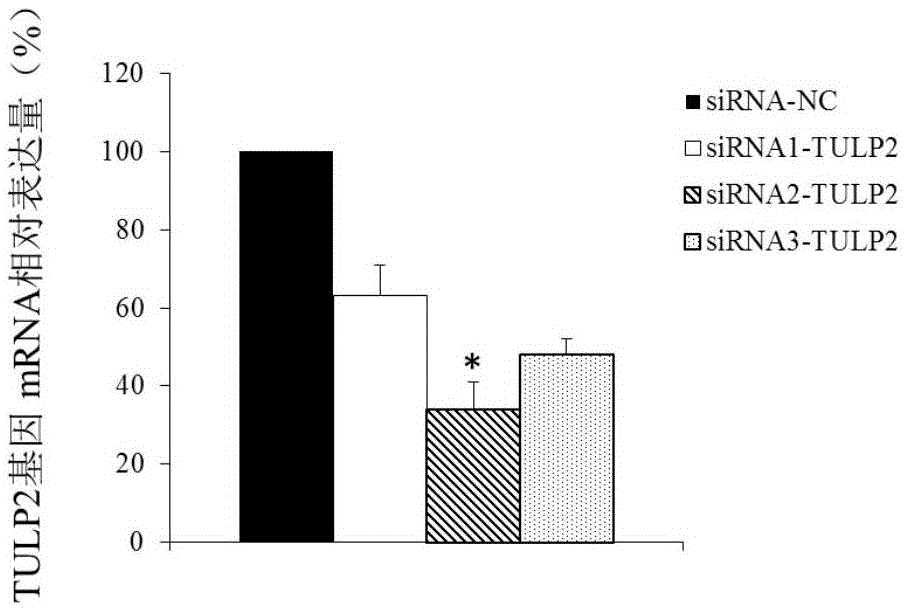Diagnosis and treatment target of degenerative disc disease
A technology for degenerative diseases and intervertebral discs, applied in bone diseases, microbiological determination/inspection, medical preparations containing active ingredients, etc., can solve the problems that the pathogenesis has not been clearly elucidated
- Summary
- Abstract
- Description
- Claims
- Application Information
AI Technical Summary
Problems solved by technology
Method used
Image
Examples
Embodiment 2
[0089] Embodiment 2 interferes with the expression of TULP2 gene
[0090] 1. siRNA design and synthesis
[0091] siRNA sequences against TULP2:
[0092] siRNA1-TULP2:
[0093] The sense strand is 5'-UCAUCAAUGUGUCAUUAUCCU-3' (SEQ ID NO.3);
[0094] The antisense strand is 5'-GAUAAUGACACAUUGAUGAGA-3' (SEQ ID NO.4),
[0095] siRNA2-TULP2:
[0096] The sense strand is 5'-AGGUAAUUAGAAGUUUUGCUC-3' (SEQ ID NO.5);
[0097] The antisense strand is 5'-GCAAAACUUCUAAUUACCUCA-3' (SEQ ID NO.6),
[0098] siRNA3-TULP2:
[0099] The sense strand is 5'-UCUUUUCCAAGUCUUCUUCCU-3' (SEQ ID NO.7);
[0100] The antisense strand is 5'-GAAGAAGACUUGGAAAAGAAG-3' (SEQ ID NO.8)
[0101] Negative control siRNA sequence (siRNA-NC):
[0102] The sense strand is 5'-CGUACGCGGAAUACUUCGA-3' (SEQ ID NO.9);
[0103] The antisense strand is 5'-UCGAAGUAUUCCGCGUACG-3' (SEQ ID NO.10).
[0104] 2. Cell culture
[0105] Put the intervertebral disc nucleus pulposus tissue into a 100ml beaker filled with 10ml2% ...
Embodiment 3
[0122] Example 3 Effect of TULP2 gene expression on proliferation of nucleus pulposus cells
[0123] 1. Use the CellCountingkit-8 (cck-8) kit to detect the proliferation of nucleus pulposus cells
[0124] 1.1 steps
[0125] The culture and transfection of normal nucleus pulposus cells were carried out according to the method of the previous embodiment 2, and the cells were divided into three experimental groups:
[0126] Group 1: Cells transfected with siRNA-NC, used as the control group;
[0127] Group 2: cells transfected with siRNA2-TULP2.
[0128] 24h after transfection, with 2×10 5 Inoculate in a 96-well cell culture plate at a density of / ml, design triplicate wells for each experimental group, 100 μl per well, place at 37°C, 5% CO 2 Incubate in an incubator, after 24 hours of cell attachment, add 10 μl of CK-8 solution to each well of the culture wells to be detected, continue to incubate in the cell incubator for 1 hour, and measure the absorbance value (OD value) ...
Embodiment 4
[0142] Example 4 Effect of TULP2 gene on apoptosis of nucleus pulposus cells
[0143] Use AnnexinV-FITC / PI double staining method to detect cell apoptosis by flow cytometry, the steps are as follows:
[0144]1. Cell transfection: The nucleus pulposus cells were transfected with siRNA2-TULP2 and siRNA-NC according to the method in Example 2.
[0145] 2. After 48 hours of cell transfection, the cells were harvested, and the cells were processed according to the operating instructions of the AnnexinV-FITC / PI Double Staining Kit (purchased from Invitrogen).
[0146] 3. The cells treated in step 2 are detected by flow cytometry.
[0147] 4. Statistical methods
[0148] Statistical cell apoptosis rate, the experiment is repeated 3 times, the result data are expressed in the form of mean ± standard deviation, using SPSS13.0 statistical software for statistical analysis, the difference between the two Using t test, it is considered statistically significant when P<0.05.
[0149] 5...
PUM
 Login to View More
Login to View More Abstract
Description
Claims
Application Information
 Login to View More
Login to View More - R&D
- Intellectual Property
- Life Sciences
- Materials
- Tech Scout
- Unparalleled Data Quality
- Higher Quality Content
- 60% Fewer Hallucinations
Browse by: Latest US Patents, China's latest patents, Technical Efficacy Thesaurus, Application Domain, Technology Topic, Popular Technical Reports.
© 2025 PatSnap. All rights reserved.Legal|Privacy policy|Modern Slavery Act Transparency Statement|Sitemap|About US| Contact US: help@patsnap.com



